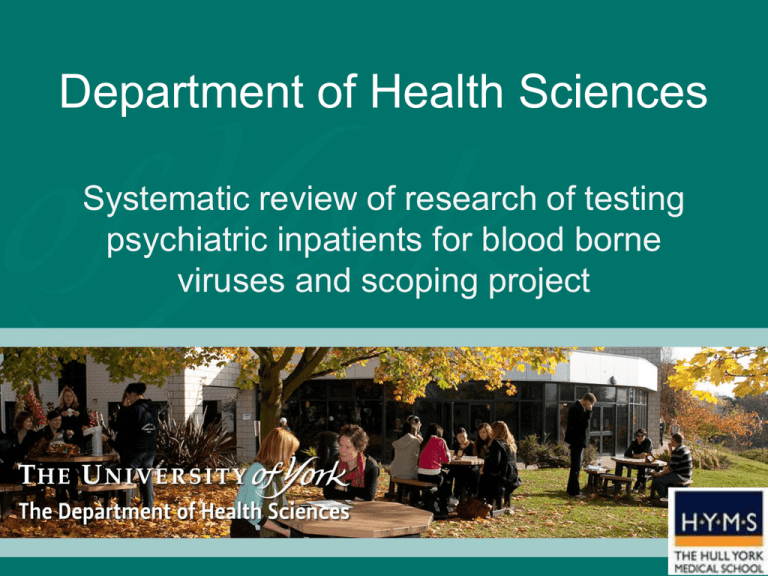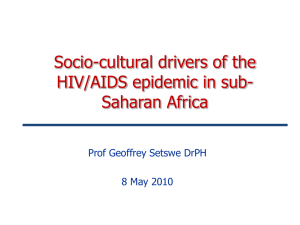
Department of Health Sciences
Systematic review of research of testing
psychiatric inpatients for blood borne
viruses and scoping project
Aims
• Background regarding sexual health and
serious mental illness (SMI)
• To present the findings of a systematic
review of prevalence of Blood borne
viruses in people with SMI
• To present the findings of the systematic
review of behavioural interventions to
reduce sexual risk taking in people with
SMI
Definition of Serious Mental health Problems
• SMI- chronic and disabling mental health problems
such as psychoses- schizophrenia, schizoaffective
disorder, bipolar, and severe depressive illness
• These usually require ongoing treatment by NHS
secondary mental health services
• Characterized as chronic relapsing conditions
• Often associated with co-morbid substance
misuse; at least a 1/3 of people receiving care for
some form of psychosis also have a significant
drug and/or alcohol problem
• Sometimes accompanied by personality disorders
as well
HIV Risk Behaviour
• People with SMI have sex and engage in high risk sexual
behaviour (unprotected anal/vaginal intercourse; sex
swapping, high risk partner e.g. IVDU)
• Carey (1999) 11% reported HIV risk behaviour.
• Carey et al (2001) reported that 23% had engaged in risky
sexual behaviour.
• Davidson et al (2001) found that half of the sample
reported being sexually active in the past year; and half of
the women and a fifth of the men reported having had sex
with causal partners without using a condom.
• Carey et al (2004) people with mood disorders had higher
rates of sexual risk behaviours, than those with SMI
• Meade (2006)41% sexual activity
–
–
–
–
–
29% multiple partners
32% non-monogamous partners
15% sex with a stranger
5% traded sex
55% never wore condoms
Why the increased risk?
• Factors associated with sexual risk-taking:
– History of childhood sexual abuse
• More likely be vulnerable to exploitation and abuse as adults
– Active symptoms
• Affecting decision-making; hyper-sexuality
– Lack of social support
• More vulnerable to exploitative and damaging relationships if choices
are limited (self-stigma too)
– Co-morbid drug and alcohol use
• Intoxication
• Obtaining drugs via sex work/ swapping
• Association with IVDUs
Team
• Shaan Bassi- Biology graduate and research
assistant
• Dr Fabiola Martin- Consultant in sexual
health and sexual health infection researcher
University of York/ Hull York Medical School
• Dr Simon Gilbody- Professor in mental health
and Head of Mental Health Research group,
University of York/ Hull York Medical School
• Members of the Leeds Dual Diagnosis Expert
Group
BBV and mental health
•
•
•
•
•
•
•
People with long term mental health problems are more at risk of
BBV than the general population
Mental health services don’t routinely offer sexual health promotion
or testing
There is evidence from the USA that having a diagnosis of
schizophrenia greatly complicates the treatment adherence and
adoption of behavioural interventions in the treatment of HIV.
There is also evidence that people with SMI have co-infection with
HIV and Hepatitis C. Hepatitis C is now responsible for more deaths
in the USA than HIV.
Hepatitis C is a chronic illness with low grade symptoms (fatigue,
malaise, low mood) which can be attributed to MH problem; however
if untreated can lead to reduced life expectancy (liver cancer,
cirrhosis) and especially problematic if heavy drinking too.
Surprisingly this is an under-researched area in the UK and there is
an urgent need for research that would help to inform the
development of routine BBV testing and treatment services within
mental health inpatient units
Also neglected by policy- mental health and sexual health policy
doesn't recognise people with SMI as a key group at increased risk.
C2D2: Scoping Project and Systematic Review
• C2D2 is a funding stream from Wellcome
Trust promoting interdisciplinary research
focusing on chronic disease conditions
• 6 months
• Collaboration between Biology (Centre for
Immunology and Infection) York/HYMS,
and Department of Health Sciences
Mental Health Research Group
Aims of the project
• Systematic review of prevalence of HIV,
Hepatitis B and C in people with serious
mental illness
• Engagement of key collaborators: service
users, NHS services, other academics
• Develop further research ideas and
proposals
Systematic review
• Participants: of any age dx with SMI*,
treated in any psychiatric setting
• Observational studies where tested for
HIV, Hep B and/or C
• Opt-in or out; consent or anonymous
unlinked
• Searched Cochrane library, MEDLINE,
EMBASE, Psychinfo, CINAHL, and DARE
jan 1st 1980-June 5th 2012
Method
• Search was undertaken
• Stage 1- after removal of duplicates, all papers were screened
by title and abstract against inclusion criteria
• Stage 2- full papers were retrieved and if fitted inclusion
criteria were included for quality assessment and data
extraction
• Discussions were had between researchers around exclusion
at stage 2 for any papers that were ambiguous
• Quality assessment- all papers were assessed using a
modifed version of the QATSO- assessed in 4 areas and
received a score of max 4
–
–
–
–
Was diagnosis clearly established as SMI
Response rate
Control for confounders
Sample size greater than or equal to 200
Results
• A total of 373 abstracts were initially retrieved and a total of 99
studies were included in the analysis (from 92 papers)
• Heterogeneous studies (no meta-analysis)
• Many were convenience samples
• Selection bias
• Only 3/99 scored 4 on modified QATSO
• Many papers failed to report rate of participation (e.g. how
many eligible people refused to participate from the
population?)
• 39% did not receive or report gaining consent from
participants
• 48% reported gaining ethical approval (22% not reporting;
29% being retrospective studies analysing medical records)
• Since 2008- this has improved. Out of 29 published studies,
76% reported ethical approval
Quality assessment questions (based on QATSO):
• If the diagnosis was clearly defined as “SMI” not
non-psychotic/primary care setting
• If the study reported a response rate? (If the
reported response rate was below 60% of the
available eligible sample- it received 0)
• If the investigator(s) controlled for confounding
factors (e.g. stratification/ matching/ restriction/
adjustment) when analyzing the associations (if
the study contains purely descriptive results and
no association and prediction tests were
conducted it received 0),
• If the sample size was more than or equal to 200.
Range of quality scores
Key HIV Prevalence Rates
•
•
•
•
•
•
A third of all studies identified in this review were conducted in the North
American continent (USA and Canada) (n=36; 36%) with an average
prevalence rate of HIV =2.9%. (gen pop=0.6%)
Africa: the highest HIV prevalence rate 24.2% (n=8).
HIV rates are also higher in the homeless populations, and those who had
high risk factors for BBV infection (such as intravenous drug use), 11.5%
(n=7) for the former and 12.7% (n=3) for the latter.
Co-morbid substance use may well be a factor of interest- Himelhoch et al.
investigated the rates of HIV and HCV in an outpatient urban sample of 153
people with serious mental illness and co-occurring substance abuse and
found HIV prevalence rate of 6.1%, USA.
De Hert et al. reported a rate of 0.5% in a sample of 595 schizophrenic and
schizoaffective patients in Belgium (11), with Beyer et al. finding a rate of
2.56% in 11,284 bipolar and psychiatric patients in outpatients, USA .
Comparatively, these samples do not offer an adjusted figure however it
suggests a higher rate of HIV prevalence in individuals with SMI compared
to the general population.
Hepatitis B and C
•
•
•
•
•
•
HBV prevalence rates in individuals with mental illness vary considerably,
from an overall prevalence rate of 40.7% in a long term psychiatric hospital
in Italy (21), 2% in a psychiatric hospital in Greece (22), with a prevalence of
14.7% and 1.64% for active and previous HBV exposure in Brazil (23) .
The use of different serological markers, in which some researchers record
current HBV infection (HBsAg positive), whilst others look at prior-exposure
(anti-HBc positive) or the overall prevalence of HBV markers, is one of the
reasons for such a dispersed prevalence rate.
HCV affects an estimated 20% of people with SMI, with the US having an
estimated prevalence of 1.8% (24).
High level of heterogeneity in the prevalence rates of HCV in individuals
with SMI, with prevalence figures ranging from 38% in US veterans on a
psychiatric ward to 0.7% in Schizophrenic and schizoaffective patients
participating in a program in Belgium (25).
Lower rates of HCV can be seen in developing countries, with 1.8% in Iran
(26), 2.7% in Eastern Turkey (27) and 2.63% in Brazil (23).
There is a high association between HCV prevalence and drug use and
injection, varying on a socioeconomic and geographical basis (24).
Discussion of findings
• Individuals with severe mental illness appear to be at greater
risk of BBVs, than general population.
• Data from the studies reviewed in this examination supporting
the elevated rates.
• There appears to be documented evidence of higher
prevalence rates of HIV, HCV and HBV in these individuals
than in the general populations
• strategies of both examining and reporting such rates needs
refining.
• Changes in types of studies- earlier ones focused on hep B,
then HIV, now recent studies are focusing on Hepatitis Creally concerning rates in psychiatric populations
• Not clear what risk behaviours this is associated withinjecting drugs is not common in SMI, the sexual transmission
route is not established, possible route via shared household
equipment such as toothbrushes and razors?
Discussion and recommendations
• Review revealed a lack of research in Europe
• UK published studies= 0!
• Most studies based on convenience samples
and potential bias present
• Urgent need for rigorously conducted
prevalence studies with a representative
sample
• Maybe even anonymous un-linked?
• Need to investigate influence of risk factors
and calculate adjusted prevalence
Dual Diagnosis Experts Group- Leeds
• Group of people (service user led) with an interest
in service development and quality for people with
both mental health and substance use issues
• Consultation meeting: to discuss the idea of
universal testing for BBV in mental health settings
• Outcomes:
– Consensus is that its better to offer to all people
rather than targeting certain “risky” people as this
normalises and reduces stigma
– However, no point in testing unless timely referral and
treatment is available (e.g. Hepatology)
– Staff attitudes- being non-judgemental about
substance use, being knowledgeable.
Prevention and Intervention
• Infection with HIV, HBV or HCV complicates an
already complex mental health problem
• Issues of side-effects, neurological effects,
treatment adherence
• Therefore, prevention is very important
• Requires behavioural changes to prevent
infection:
–
–
–
–
Health promotion advice
Access to condoms
Social skills
Motivational work
Systematic review of psychosocial interventions to reduce sexual
risks
• 11 studies (all RCTs) all based in USA
• Poor to moderate quality
• Heterogeneous in sample, measures,
intervention, controls etc (therefore unable to
perform meta analysis)
• However: some studies showed significant
reductions in VEE (Vaginal episode
equivalent) up to 6 months post intervention
• Demonstrates that it is acceptable and
feasible to offer an intervention to people with
serious mental health problems related to
sexual behaviour
Adequate sequence generation?
Allocation concealment?
Blinding?
Incomplete outcome data addressed?
Free of selective reporting?
Free of other bias?
Berkman et al 2006
?
?
?
-
-
-
Berkman et al 2007
+
+
+
+
+
-
Carey et al 2004
?
?
?
?
+
-
Collins et al 2011
+
+
+
+
+
-
Kalichman et al 1995
?
?
+
-
-
-
Katz et al 1996
?
?
+
-
?
-
Kelly et al 1997
?
?
?
-
+
-
Otto-Salaj 2001
?
?
?
-
-
-
Rosenberg et al 2010
?
?
?
-
+
-
Susser et al 1998
+
+
+
+
+
-
Weinhardt 1998
?
?
+
-
+
-
Intervention and Follow-up
•
•
•
•
•
•
•
•
•
•
•
•
Kalichman et al 1995 4x 90 mins (waiting control) 1 and 2 mth f/up * reduced unprotected sex
Katz 1996- 4x 2 hr with post test and 2 week f/up (educ and skills) 3 th f/up * improvement in knowledge and
confidence
Kelly 1996- 7 session (90mins) CBT + advocacy v CBY vs 1 60min edu session- f/up 3 months * no
differences across groups overall
Susser (1998) 15 session CBT skills v 2 session AIDS education 6 and 18mth f/up *mean scores VEE in int
group
Weinhardt (1998) 10 session assertive skills, HIV educ v wait list -2 and 4mth follow-up signif increase in
condom use sexual assertiveness HIV knowledge
Otto-Salaj (2001) 7 session CBT skills v 7 session “healthy lifestyle” 3,6,9, 12mth f/up varied by gender,
more effective for women; men only showed incr in knowledge
Carey (2001) 10 sessions 2x wkly over 5 weeks HIV intervention v SU v Standard 3, 6mth signif reduction in
risk behaviours
Berkman (2006) 2x 1 hr sessions total of 6 v 1x 2 hr HIV education f/up to 6 months no significant
differences
Berkman (2007) enhanced Sex-G + peer advocacy v 10 sessions social skills and money management 6,
12 mth f/up no differences on risk behaviour
Collins (2001) 10 session female only 10 sessions signif increased positive attitude 6 week f/up
Collins 2011- female only 10 sessions v money management reduction not significant but more likely to use
female condom at 6 mths
Rosenberg (2010) STIRR immunisation and screening mainly with some counselling and educ, v enhanced
standard care 3 sessions over 6 months, 12mth f/up * increased participation in services, but no change on
risk behaviour and HIV knowledge
23
23
Sample size
Only included
those with risk
factors for HIV
Dose (total
hours)
Main Outcome
Follow-up
period
Significant effect on sexual behaviour outcome (p<0.05)
Berkman 2006
92
No*
6
VEE
6 months
no
Berkman 2007
149
yes
10
VEE
6 months
no
Carey 2004
408
yes
10
Count of episodes of
Unprotected vaginal sex
6 months
Yes: HIV intervention group had significantly reduced
unprotected vaginal intercourse both compared to SUR
(p<0.001) and standard care (p<0.004). Significantly fewer
casual partners in HIV vs. control (p<0.0001) at follow-up
Collins 2011
79
yes
10
VEE
6 months
no
Kalichman 1995
52
no
6
Count of episodes of
Unprotected vaginal sex
2 months
no
Katz 1996
37
no
8
Behavioural assessment
(role-play)
2 months
no
Kelly 1997
104
yes
10.5
Number of sexual partners
3 months
Yes, at 3, 6 and 9 months (not 12months) Advocacy had
fewer partners than CBT (p<0.02) and fewer unprotected
acts (p < 0.01).
Otto-Salaj 2001
189
yes
14
Reported condom use
3, 6, 9. 12
months
Yes Increase in condom use by women in intervention at
3/12 (p<0.02), 6/12 (p<0.01) and 9/12 (p<0.04) not 12
months
Rosenberg** 2010
236
yes
3
AIDS risk inventory score
6 months
no
Susser 1998
97
No*
15
VEE
6 & 18 months
Yes: At 6/12: VEE mean score for intervention was 1.0,
control 3.1 (p=0.01) with less "high risk" behaviour in
intervention group (p = 0.01). No significant difference by
18 months
Weinhardt 1998
20
yes
12.5
Number of protected
sexual intercourse
2 and 4 month
Yes at 2 months, no at 4 months
Implications for Practice-more questions than answers!
• Education and prevention work developed with
specific needs of people with SMI- need more
research on what works.
• Screening and testing- definitely, but which service?
– Phlebotomy, competence in pre and post test advice
– Do mental health nurses see this as a part of their role?
• Care pathways to hepatology and HIV specialisms
BUT complications of co-morbid drug and alcohol,
poor adherence and polypharmacy
• What are the workforce needs in treatment settings in
adapting care for those with SMI?
• Implications for commissioning in the new health and
social care landscape
Acknowledgements:
Dr Chloe Walsh Dr Peter Phillips (City University) and
Dr Edward McCann (Trinity College Dublin) for
undertaking the systematic reviewing searches,
retrieval and data extraction for the interventions review
and Shaan Bassi for his work on the BBV review
Also acknowledge the C2D2 funding programme for
Chronic Diseases that funded the BBV review project.






